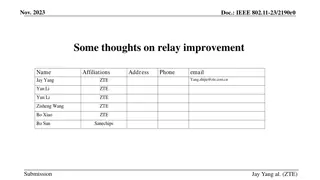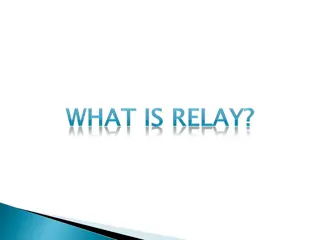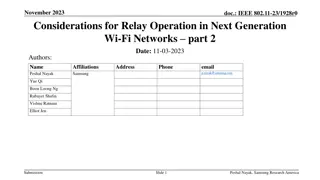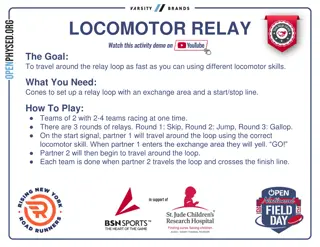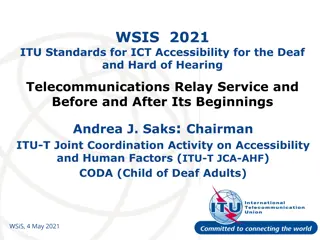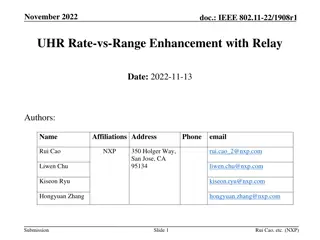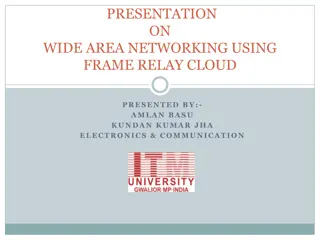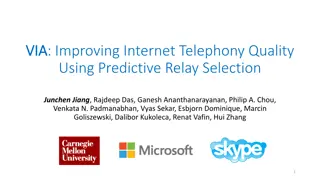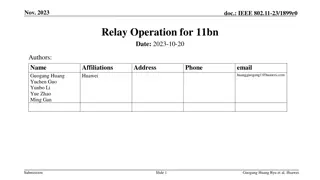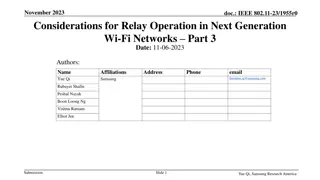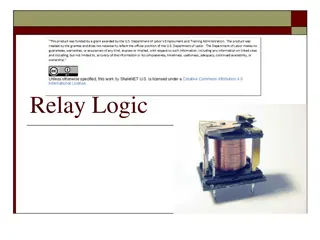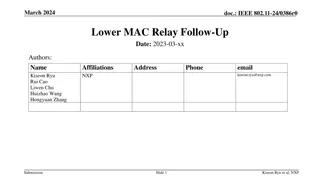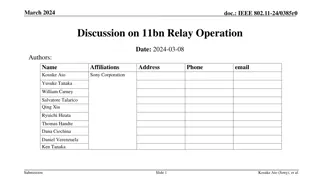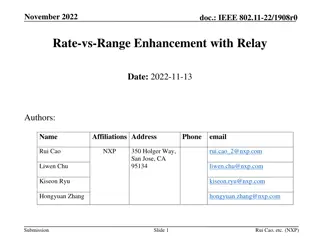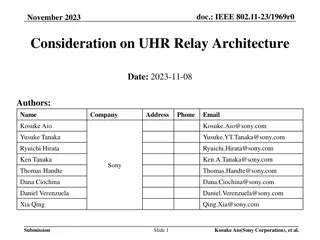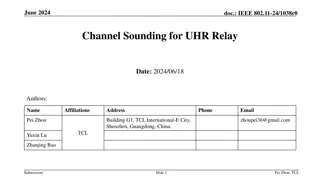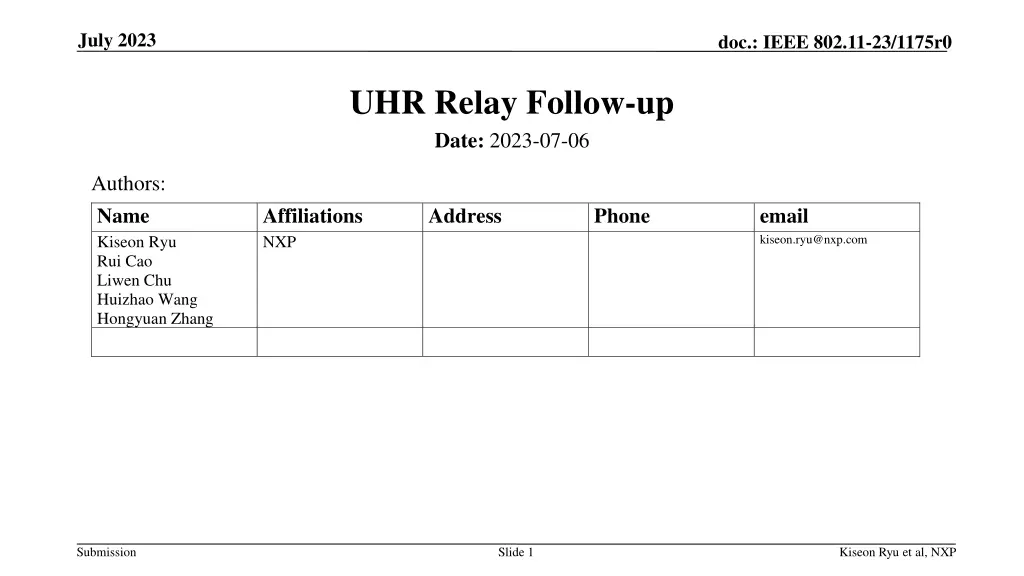
UHR Relay Implementation Overview
Explore the potential solutions for implementing a relay protocol in UHR to improve Rate-vs-Range (RvR) performance, throughput, and range extension at medium to low SNR regions. The document discusses the design principles, challenges, and high-level concepts of UHR relay, including achieving better QoS, simplifying relay protocols, enabling cost-effective designs, and supporting relay within a single TXOP. Dive into the details of how relay nodes can enhance connectivity and performance in IEEE 802.11 networks.
Download Presentation

Please find below an Image/Link to download the presentation.
The content on the website is provided AS IS for your information and personal use only. It may not be sold, licensed, or shared on other websites without obtaining consent from the author. If you encounter any issues during the download, it is possible that the publisher has removed the file from their server.
You are allowed to download the files provided on this website for personal or commercial use, subject to the condition that they are used lawfully. All files are the property of their respective owners.
The content on the website is provided AS IS for your information and personal use only. It may not be sold, licensed, or shared on other websites without obtaining consent from the author.
E N D
Presentation Transcript
July 2023 doc.: IEEE 802.11-23/1175r0 UHR Relay Follow-up Date: 2023-07-06 Authors: Name Kiseon Ryu Rui Cao Liwen Chu Huizhao Wang Hongyuan Zhang Affiliations NXP Address Phone email kiseon.ryu@nxp.com Submission Slide 1 Kiseon Ryu et al, NXP
July 2023 doc.: IEEE 802.11-23/1175r0 Introduction In the UHR PAR document [1], RvR (Rate-vs-Range) improvement is described as one of the main objectives in the UHR project. According to [2], relay can improve RvR by increasing throughput and extending range at medium to low SNR regions. In this document, we discuss high level potential solutions to implement a relay protocol in UHR. Submission Slide 2 Kiseon Ryu et al, NXP
July 2023 doc.: IEEE 802.11-23/1175r0 Recap) Motivations: Range extension using relay nodes [2] rSTA tSTA dSTA Direct link (tSTA-dSTA) SNR is low, and cannot support desired MCS/Tput A relay (one as a simple case) decodes and retransmits the PPDU Relay has better link quality to both tSTA and dSTA Use case 1: medium data rate Source-Destination within regular BSS coverage (beacon/RTS/CTS) Use case 2: Lowest rate Need enhancement design of management/control frames Submission Slide 3 Kiseon Ryu et al, NXP
July 2023 doc.: IEEE 802.11-23/1175r0 Recap) UHR Relay Design Principle [2] Achieve throughput and range enhancement at medium to low SNR region with better QoS (latency, jitter, etc.). To address the challenges in existing solutions, UHR needs to define relay solutions to Improve multi-hop channel access delay E.g. TXOP sharing enhancement Enhance end-to-end QoS E.g. end-to-end BA/ACK protocol Simplify relaying protocol Reduce relay processing complexity E.g. single user relay, simpler relay signaling, no encryption/decryption, reduced relay packet processing delay Enable cost-effective designs: non-AP STA/uAP can support relaying Much simpler than multi-AP protocol Submission Slide 4 Kiseon Ryu et al, NXP
July 2023 doc.: IEEE 802.11-23/1175r0 High Level Concept of UHR Relay Support Relay within a single TXOP using TXOP sharing Retransmission by an end device (AP or STA), based on the end-to-end BA/Ack protocol SU relay support for DL (AP STA) and UL (STA No MU relay support for both DL and UL No UL TB tx in a relay TXOP BF support: AP Relay, Relay STA OK to support single user BF, not on critical data exchange protocol A relay device may support both a Bfee and a Bfer Sounding protocol can be for each link individually or can be coordinated by an AP AP) Submission Slide 5 Kiseon Ryu et al, NXP
July 2023 doc.: IEEE 802.11-23/1175r0 Potential Solution: Lower MAC Relay (Architecture) Lower MAC Relay provides Hop-by-hop block acknowledgement via relay link and the end-to-end security/SN processing A relay device (rSTA) involves only Lower MAC functions (U) (C) (U) (C) IEEE 802.1X IEEE 802.1X Controlled and Uncontrolled Port Filtering (optional) (M) Controlled and Uncontrolled Port Filtering (optional) (M) RX/TX MSDU Rate Limiting RX/TX MSDU Rate Limiting A-MSDU MSDU Flow - Transmitting A-MSDU MSDU Flow - Transmitting MSDU Flow Receiving MSDU Flow Receiving Aggregation (TX) / De-aggregation (RX) Aggregation (TX) / De-aggregation (RX) Replay Detection Per PN (optional) Replay Detection Per PN (optional) PS Defer Queuing1 (AP MLD Only) PS Defer Queuing1 (AP MLD Only) Upper MAC sublayer: tSTA/dSTA only functions Block Ack Buffering and Reordering per SN Block Ack Buffering and Reordering per SN A-MPDU processing Sequence Number Assignment Sequence Number Assignment MPDU Decryption MPDU Decryption Optional Relay BlockAck Scoreboarding, etc. Note: It is similar to per-link functions in the EHT ML framework. End devices (transmitter STA: tSTA, and destination STA: dSTA) involve both Upper MAC functions Packet Number Assignment Packet Number Assignment Duplicate Detection per SN Duplicate Detection per SN E2E Block Ack Scoreboarding E2E Block Ack Scoreboarding MPDU Encryption MPDU Encryption Null Null Null Null Relay Block Ack Scoreboarding Relay Block Ack Scoreboarding Null MPDU Header + CRC Creation MPDU Header + CRC Creation MPDU Header + CRC Creation Address 1 address filtering Address 1 address filtering Address 1 address filtering lower MAC sublayer: Relay functions MPDU Header + CRC Validation security process MPDU Header + CRC Validation MPDU Header + CRC Validation A-MPDU Aggregation SN generation/reordering A-MPDU Aggregation A-MPDU Aggregation A-MPDU De-aggregation A-MPDU De-aggregation A-MPDU De-aggregation E2E Block Ack Scoreboarding, etc. Lower MAC functions (PHY SAP) (PHY SAP) (PHY SAP) PHY of tSTA PHY of dSTA PHY of rSTA A-MPDU processing Optional Relay BlockAck Scoreboarding, etc. Note: It is similar to MLD functions with upper MAC functions and lower MAC functions in the EHT ML framework. dSTA tSTA rSTA Submission Slide 6 Kiseon Ryu et al, NXP
July 2023 doc.: IEEE 802.11-23/1175r0 Lower MAC Relay (Overall procedure) Procedure Relay TXOP protection/sharing can be done by exchanging MAC Control frames (e.g., (MU-)RTS/CTS frames) among a tSTA, an rSTA and a dSTA. The tSTA transmits the 1st hop frame to the rSTA. The rSTA may respond with a 1st hop BA frame (or Ack frame). The rSTA transmits a 2nd hop frame to the dSTA With MPDU(s) successfully received in the 1st hop frame The dSTA may transmit a 2nd hop BA frame (or Ack frame). The rSTA may transmit an E2E BA frame (or Ack frame) to the tSTA. Note. The E2E BA frame may not be present when the tSTA is a non-UHR STA. 1st hop frame tSTA Frame exchange for Relay TXOP protection 1st hop BA/Ack E2E BA/Ack 2nd hop frame rSTA 2nd hop BA/Ack dSTA Note. The additional address information (e.g., AIDs of source, destination and transmitter STAs) can be included in a frame that is relayed, in addition to the A1/A2/A3 fields. Submission Slide 7 Kiseon Ryu et al, NXP
July 2023 doc.: IEEE 802.11-23/1175r0 DL/UL Relay procedure DL Relay Procedure UL Relay Procedure Non-AP STA Relay AP Non-AP STA Relay AP TXOP Protection TXOP Protection 1st hop frame 1st hop frame 1st hop BA/Ack 1st hop BA/Ack 2nd hop frame 2nd hop frame 2nd hop BA/Ack 2nd hop BA/Ack *E2E BA/Ack (for UHR STA) E2E BA/Ack *E2E BA/Ack is not present for a non-UHR STA Submission Slide 8 Kiseon Ryu et al, NXP
July 2023 doc.: IEEE 802.11-23/1175r0 Example of DL retransmission for relay operation Relay TXOP 1 for Tx Relay TXOP 2 for ReTx ReTx SN: 107-109 Tx SN: 100-109 Update E2E BA scoreboard (100-106) Update E2E BA scoreboard (100-109) 1st hop frame 1st hop frame AP Frame exchange for Relay TXOP protection Frame exchange for Relay TXOP protection Acked SN: 107-109 Acked SN: 100-108 Tx SN: 100-108 Tx SN: 107-109 1st hop BA 1st hop BA E2E BA E2E BA 2nd hop frame 2nd hop frame Relay Acked SN: 100-106 Acked SN: 107-109 Rx SN: 100-108 Rx SN: 107-109 Acked SN: 100-106 Acked SN: 107-109 2nd hop BA 2nd hop BA SIFS SIFS Non-AP STA Rx SN: 100-106 Rx SN: 107-109 Relay operation can be performed only within a single TXOP Failed MPDUs over 1st hop and 2nd hop links, that is based on the E2E BA frame, can be retransmitted by the AP in a separate TXOP. The relay device may discard recorded SNs and the Tx buffer for relay transmission after the TXOP. Relay BA scoreboarding at the AP and at the non-AP STA may not be needed unless the AP and the relay device retransmit failed MPDUs based on the 1st hop BA and the 2nd hop BA frames. The 1st hop BA frame can be used for link adaption of the 1st hop link, not for relay BA scoreboarding + reTx for failed MPDUs for the relay device. Submission Slide 9 Kiseon Ryu et al, NXP
July 2023 doc.: IEEE 802.11-23/1175r0 Summary RvR (Rate-vs-Range) improvement is one of the main objectives of UHR. This contribution introduces a high-level relay concept to improve RvR for UHR with the following design principles. Relay within a single TXOP, using TXOP sharing Retransmission by end devices, based on the end-to-end BA/Ack protocol SU relay support for DL and UL, and no MU relay support In this document, we review a simple relay solution. Suggest to define a relay protocol in UHR to improve RvR with simple relay processing. Submission Slide 10 Kiseon Ryu et al, NXP
July 2023 doc.: IEEE 802.11-23/1175r0 Straw Poll Do you support to define a relay protocol in UHR to improve RvR (Rate-vs-Range) with simple relay processing? Yes No Abstain Y/N/A: Submission Slide 11 Kiseon Ryu et al, NXP
July 2023 doc.: IEEE 802.11-23/1175r0 References [1] IEEE 802.11-23/0480r3 UHR proposed PAR [2] IEEE 802.11-22/1908r1 UHR rate-vs-range enhancement with relay Submission Slide 12 Kiseon Ryu et al, NXP

